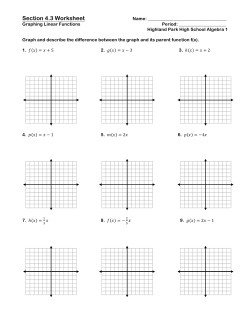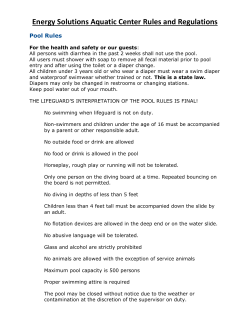
Energy Saving Strategies for Pools
4/22/2015 Regenerative Media Filters Engineered For Sustainability : • 90% Less Water and Waste • 30% Less Fuel & Chemicals • 75% Less Construction (space and labor) • 50% Less Electrical Power • Superior Water &Air Quality Rapid Return on Investment Regenerative filter will typically pay for itself in as little as 2 to 5 years. Cost Savings Analysis tool can help project your own ROI. 1 4/22/2015 The Flex Tube ½” T304L stainless steel coil wrapped in a high strength polyester weave Gains 1/8”average media coating per side creating over 0.78 ft² of surface area per 4ft tube 9 to 12 times the filter area of an equivalent sand filter The “Bump” Filter Tubes in Precoat State Air is quickly exhausted from bump tire Perlite is loosened from flex tubes as tube sheet descends Bump tire re-inflates Forced water expands flex tubes enhancing perlite release 2 4/22/2015 How it Works: Regeneration Regeneration Filter Tube Benefit #3: Save Perlite forms 1/8” layer of media on flex tubes Filtered particulate is captured on outer surface of perlite Bump releases perlite to expose fresh media surface area on Construction Regenerative filters typically require just ¼ of the space needed for equivalent high rate sand filters.This example represents a savings of 164 ft² 19 ft 6 ft 8 in Total Footprint: 58 ft² 11 ft 8 in Total Footprint: 222 ft² 8 ft 8 in One 49” dia. Defender does the same work as four 48” X 84” sand filters! 3 4/22/2015 Benefit #3: Save on Construction Construction Cost Savings: No backwash holding tank Smaller waste line to sewer Reduced sewer permitting fees Local backwash to waste flow rate restrictions are no longer an issue Operating wt as low as 2 ton vs. 20 ton w/ sand Regenerative filters helps earn LEED points… Related Labor Savings Installation General construction Rigging Handling Piping Media loading Operation Media replacement Less routine maintenance Reduced long-term maintenance 4 4/22/2015 Benefit #5: Improve Health & Safety: Water Quality Particle removal down to 1 Micron Removes 99.95% of crypto in a single pass Improves UV efficiency Air Quality Building Integrity Water Quality How Small is a Micron? The average human hair is roughly 100 microns wide! Questions and Answer Norm Hamelin Aquatic Source Aquatic Specialist AFO & CPO certified 5 4/22/2015 Energy Saving Strategies for Pools • Pools can be a great school and community asset, but they do require resources to maintain them. From maintenance to energy usage, pools can be expensive to operate. There are ways to reduce these costs, however particularly by utilizing good management strategies. Learn how to leverage operational practices and various types of equipment to significantly lower energy consumption with your pool. • Energy savings thru pool room equipment integration • Improved water quality • Resulting improved air quality reduces demand for fresh makeup air • Not having to heat as much air saves significantly on heating costs • Significant savings on electric, natural gas, and water • Impressive ROI with continued energy savings thereafter • Incentive grant money often can improve the ROI 1 4/22/2015 $120,000.00 $100,000.00 $80,000.00 $60,000.00 $40,000.00 $20,000.00 $0.00 2010 2012 Billing 2 4/22/2015 Symptom: Poor air quality due to water chemistry at indoor pools Problem: Chlorine disinfection by-products (DBP’s) off-gas in a corrosive vapor Solution: Add UV technology to continuously reduce DBP’s in the filtered water Added benefit: Energy savings Improving the water results in improved air quality If facilities use significantly more fresh make-up air than ASHRAE 62.2 minimums, serious energy savings can result from reducing the volume of make-up air Integrating technologies to automate to process Chemical controller continuously measures (DBP’s) in water, adjust energy levels of the UV, VFD’s, and HVAC supply. Improved filtration reduces water wasted by 80% 3 4/22/2015 UV Benefits in Aquatics Naturally controls chloramines Indoor pools High level disinfectant Chlorine resistant pathogens like “Crypto” The Facilities Department of USA Swimming strongly recommends that all pools, both new and existing, have UV systems installed…When compared to chlorine feeder systems, Ultra Violet systems involve a higher initial capital cost. However, over the life of the pool Ultraviolet technologies reduce the on-going operating and maintenance costs. This can be significant.” Mick Nelson, USA Swimming Facilities Department 4 4/22/2015 Cost Savings Energy – natural gas, water, & electrical (when adding VFD’s) Corrosion – HVAC, railing, deck equipment, light fixtures, swimsuits Chemicals – no shocking required, pool open longer, lower TDS levels Reduced risk – RWI outbreak, athletic asthma, respiratory issues Maintenance – labor, service 5 4/22/2015 Energy Management Integrating UV, VFD’s, and controllers with the HVAC • • By controlling chloramines in the water, we can reduce fresh make-up air Most indoor pools bring in many times more fresh air than what is required by ASHRAE 62.2 • Presented at the 2013 World Aquatic Health conference 6 4/22/2015 The History of Variable Frequency Drives ‐ VFD’s have been used for more than 30+ years ‐ Prominent in Europe for decades ‐ Prior to 1990’s, primarily used in just heavy industrial applications in the United States ‐ 1/3 of the world’s electrical energy is consumed by electric motors in pump, fan & compressor applications ‐ Due to increasing energy costs & improved performance technologies, VFD’s are now being integrated on numerous applications, especially in aquatics. 1 What is a Variable Frequency Drive? A VFD is an electronic device that: ‐ Controls the speed of an electric motor by varying the supply frequency (Hz) (Converts AC to DC inverts back to AC) ‐ Provides continuous control, matching motor speed to the specific work demand needed ‐ VFD’s are sized based on amps in conjunction supply voltage (208/230V or 460V) ‐ There are 63 manufacturers of VFD’s in the world today ‐ Most VFD’s are not designed / suited for pool mechanical rooms 2 1 4/22/2015 How does a Variable Frequency Drive work? Pulsed Width Modulated output (Variable Frequency) Sine Wave Power (AC) 60 Hz Supply Voltage Variable Frequency Drive 3 What should an Aquatic VFD do for you? ‐ ‐ ‐ ‐ Be durable, have longevity Protect your equipment Easily operated / pool specific Maximize your energy savings potential w/out compromising water quality 4 2 4/22/2015 Durable & Longevity Environment Pool Room Chemical Gases likely Pool Room No Chemical Gases NEMA 12 NEMA 1 5 Why NEMA 12? Pool Room Chemical Gases are almost a certainty NEMA 12 - essential NEMA 1 - unsuitable Corrosion to VFD circuit board tracks 6 3 4/22/2015 Protects your equipment 7 Soft start / stop the motor ‐ ‐ ‐ Reduces the thermal/mechanical stress Eliminate water hammer, protect your pipes and plumbed equipment Significantly reduces starting current (Amps) 8 4 4/22/2015 “Brownouts” Under voltage is defined as a condition where the applied voltage drops to 90% of rated voltage, or less, for at least 1 minute. Low‐voltage conditions occur when a facility asks for more power than the line can deliver. Low voltage means higher current and increased heat in the motor 9 Excessive heat is a problem for motors because: ‐ insulation life is halved for every 10°C increase in temp ‐ at the same time, the temperature of the winding will rise 10°C to 15°C for each 10% drop in voltage. Under voltage events that last long enough to increase winding temperature cause irrevocable damage to winding insulation and unexpected failures later. 10 5 4/22/2015 Pump Cavitation If we move too far right on the curve, the water supply into the pump becomes insufficient to avoid boiling within the volute. The high pressure bubbles explode and eat away at the pump impeller and volute. Partially closing the discharge valve can prevent this but this technique wastes energy! 4 Months Old Cavitated Impeller 6 Months Old Cavitated Impeller (Public School, St. Louis, MO) 11 Pump Dry Run / Dead Head Protection A large resort hotel in Maui recently suffered $100K in damage when an operator inadvertently closed a discharge valve on the pump. The pump continued to run, the pump melted and the below grade pump room flooded. The shaft power load curve monitoring function that would have detected the dead head condition and immediately shut down the pump. 12 6 4/22/2015 Lightning Strikes Lightning damage to circuit board When Lightning strikes a building, it is quite common for any electronics within the building to be damaged or destroyed. 13 14 7 4/22/2015 Lightning Arrestor Certain areas of the Country experience recurrence of lightning activity. Electronic equipment connected to power supply lines that are hit by a lightning strike, is inevitably destroyed unless protected by a Lightning Arrestor. Lightning Arrestor installed in Bypass Panel if supplied as an Option in project Lightning Arrestor installed in base of VFD if no Bypass Panel Option included in project 15 Bypass Panel Should the VFD ever need to be removed for service, the Bypass Panel will allow the Operator to continue running the pump by means of selecting Bypass from the door mounted key switch Eco-Flow Controller built into door of Bypass Panel VFD / Bypass Selector Switch with key lock NEMA 12 Panel Bypass Contactor with Motor Overload 16 8 4/22/2015 Ease of VFD Operation ‐ Pool Specific 17 • VFD’s are extremely flexible and can be applied to many applications • The Pool pump is a relatively simple application • VFD Instruction Manuals are typically have 200-300 pages in length • Most VFD’s have 250-300 parameters that can be adjusted • Most pool room operators are not familiar with VFD’s 18 9 4/22/2015 19 VFD programming is complex and comprises literally hundreds of menus to wade through. However some vfd’s have a simpler method of operation. Enter Password Set Date Set Time Set Motor Details Controller Set Motor Supply Voltage Set Motor HP From Motor Nameplate Set Motor Amps Set Motor RPM Set Max Speed Pump to run at Set Backwash Speed Set Backwash Duration Single Wire Modbus Communication Select ‘run at fixed speeds’ Select run at ‘Constant Flow’ Set one fixed speed or two fixed speeds Select run at Constant Flow with fixed Night time speed 20 10 4/22/2015 Maximize Your Energy Savings 21 Engineering & Design of a Pool • Engineers are cautious when sizing, pipes, valves and pumps • Flow rates are difficult to determine at the design stage • Future facility expansion is sometimes factored in • Control valves are typically used to adjust flow rates after the pool is built • Energy efficiency has not been so important in years past 22 11 4/22/2015 Controlling the flow rate with a valve is like driving your car with your foot on the brake and gas at the same time. Both waste energy! Chart Title Annual Operating Electrical Cost at Fixed Speed $19,600 $20,000.00 $18,000.00 $16,800 $15,400 $16,000.00 $14,000 $14,000.00 $13,200 $12,000.00 $11,000 $10,000.00 $8,000.00 $10,500 20HP $9,000 $7,500 15HP $6,000.00 $4,000.00 10HP $2,000.00 $0.00 kWh cost @ .10 cents kWh cost @ .12 cents kWh cost @ .14 cents 24 12 4/22/2015 10HP 8,760 Operating Hours (24/7/365) A 10HP will consume approx. 75,000 kWh Reduce Speed by 10% (500 gpm to 450 gpm) Will save approx. 15,000 kWh’s a year Reduce Speed by 20% (500 to 400 gpm) Will save approx. 30,000 kWh’s a year 15HP 8,760 Operating Hours (24/7/365) A 15HP will consume approx. 110,000 kWh Reduce Speed by 10% Will save approx. 27,000 kWh’s a year Reduce Speed by 20% Will save approx. 50,000 kWh’s a year 13 4/22/2015 20HP 8,760 Operating Hours (24/7/365) A 20HP will consume approx. 140,000 kWh Reduce Speed by 10% Will save approx. 35,000 kWh’s a year Reduce Speed by 20% Will save approx. 67,000 kWh’s a year Implications of wasting energy • Approx 300,000 commercial pools in the US • Average size commercial pool pump motor is a 10 HP • Majority of commercial pool pumps run 24/7 • Energy consumed by all the commercial pool pumps is approx 2,250 Megawatts • A typical Power Plant is 500 Megawatts… • We need 4.5 Power Plants to run just the commercial pool pumps in the US •Slowing down the pool pump speeds by 24% reduces the # of power plants required to just 2 Note: Residential pool pumps offer an even larger opportunity to positively impact energy consumption. In CA alone, it takes 6 average size power plants to operate the State’s 1.5 million pools! Information Provided by National Energy Commission 14 4/22/2015 Pump Speed / Power relationship % Speed (rpm) Energy Consumption 100 Reducing Frequency reduces pump speed 90 80 70 60 50 40 30 Filter 20 10 Automatic Flow Control Eco-Flow-C Eco-Flow-C Controller As the filter gets dirty: Discharge Pressure drops & Eco-Flow-C automatically increases the pump’s speed to maintain a constant flow Supply Voltage 4-20mA signal proportional to pressure Flow Meter To Pool Pressure Sensor Note: The pump’s speed must never be adjusted to be below that required to meet a States mandated turnover Requirements, i.e., a 6-hour turnover in most States From Pool 30 15 4/22/2015 Maintaining Constant Flow Constant Flow Pump Speed To Pool FILTER Pressure From Pool 31 Questions or Comments? 32 16 4/22/2015 Thank You 33 17
© Copyright 2025










